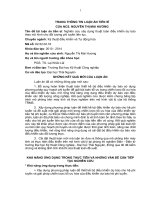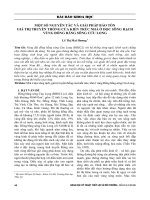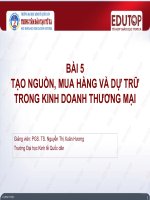Nguyen thi mai huong
Bạn đang xem bản rút gọn của tài liệu. Xem và tải ngay bản đầy đủ của tài liệu tại đây (315.21 KB, 13 trang )
ESSAY TEST
Consumer Behavior – MKT201
Name : NGUYEN THI MAI HUONG
Student ID : HS153120
Class : MKT1610
Course : MKT201
Lecturer : LE THI VIET HA
TABLE OF CONTENTS
I.
Introduction…………………………………………………02
II.
Analyze the chosen factors………………………………….03
Explain why it is the most important in Consumer Behavior.
1. Cultural factors……………………………………….…….03
2. Social factors………………………….…………………....04
3. Personal factors……………………………………………..04
4. Psychological factors……………………………………..…05
III.
Example that related to brands………………………………07
IV.
References…………………………………………………...10
2
2
I.
Introductions
The world is too big and there are many things to do, including a routine and familiar
job for each of us that is consumer behavior. When you enter the store, you are in
front of thousands of goods that you can buy. Of course, due to limited financial
resources, you cannot buy everything you want. So with available resources, you will
decide to buy a basket of goods that best meet your needs and wants after considering
the selling prices of many different goods.
So consumption behavior is understood as the reactions that individuals show in the
process of making a decision to buy certain goods or services.
Understanding consumer behavior will help businesses make appropriate products,
marketing and sales strategies.
Consumer behavior can directly influence the decision to purchase or refuse products
of a business. This has important implications, including planning marketing
strategies. Buyer behavior is influenced by four major factors: cultural, social,
personal, and psychological. All of these factors give us the basis to know how to
reach and serve buyers more effectively.
Therefore, studying consumer behavior along with the factors affecting consumption
behavior helps marketers to recognize and predict the consumption trends of each
specific customer. From there, make timely and effective marketing plans. Marketers
must study the wants, perceptions, preferences, and selection and purchasing
behaviors of target customers. Such research will give us suggestions for developing
new products, product features, pricing, channels, informational content and other
elements of the business's marketing. For effective marketing, you need to understand
your customers. Listen carefully to understand the views and feelings of your target
customers - especially when they are related to your product or service - and make
sure to communicate directly with them. Research the market to uncover new trends
and golden opportunities that can benefit your business.
The consumer market buys goods and services for personal consumption. It is the
ultimate market where economic activity is organized to serve it. When analyzing a
market the consumer needs to know the customer, the target audience, and the buyer's
goals, the operating organizations, the buying waves, and the retail stores.
Buyer behavior is influenced by four main factors: Cultural, social, personal, and
psychological. All of these factors give us the basis to know how to reach and serve
buyers more effectively.
3
3
II.
Analyze the chosen factors.
Explain why it is the most important in
Consumer Behavior.
The degree of consideration when shopping and the number of people involved in
shopping increases with the complexity of the shopping situation. Marketers must
have different plans for the four types of consumer buying behavior. Complex
shopping behavior, satisfaction-assured shopping behavior, conventional shopping
behavior, and variety-seeking shopping behavior. These four behavioral patterns are
all based on high or low levels of consumer involvement in shopping and there are
more or less major differences between brands.
1. Cultural factors
It is the most basic factor that determines the will and behavior of shoppers. For
example, when Vietnamese people buy goods, they are always influenced by
cultural factors bearing national identity that affect the value of choice. Marketers
need to consider these factors when designing marketing strategies or advertising
messages, product colors and designs or salespeople's attitudes.
1.1 Culture
Culture is the most fundamental determinant of a person's desires and
behavior. A child as he grows up accumulates a number of values,
perceptions, interests, and behaviors through his family and other key
institutions. A child growing up in the United States was exposed to the
following values: Achievement and success, activity, performance and
practicality, progress, material comfort, individualism, freedom, external
comfort, humanitarianism and youthfulness.
1.2
Cultural branch
Each culture has smaller subcultures that create more specific
characteristics and socialization levels for its members. Subcultures make
up important market segments, and marketers often design marketing
products and programs according to their needs. Linda's shopping
behavior will be influenced by characteristics of her subculture. They will
influence her eating preferences, clothing choices, leisure and career
ambitions. She may come from a subculture that places a great deal of
4
4
emphasis on "educated people" and this helps explain why she is
interested in computers.
1.3
Social class
Almost all human societies exhibit obvious social stratification. This
stratification sometimes takes the form of a caste system whereby
members of different castes are raised and trained to take on certain roles.
More common is the case of stratification into social classes.
2.
Social factors
A consumer's behavior is also influenced by social factors such as family, social
roles and status, and reference groups.
2.2 Reference group
A person's reference group includes those groups that have a direct (faceto-face) or indirect influence on a person's attitudes or behavior. Groups
that have a direct influence on a person are called membership groups.
These are groups in which the person belongs and interacts. There are
groups that are primary groups, such as family, friends, neighbors, and coworkers, with whom the person communicates frequently. Primary groups
are often more formal in nature and require less frequent communication.
2.3 Geographic roles:
Each role is associated with a status that reflects the general respect of
society, appropriate to that role. Therefore, buyers often choose products
that speak to their roles and status in society. Marketers need to be aware
of the social status of products and brands. However, status not only
varied according to social classes, but also varied geographically.
3.
Personal factors
Buyer decisions are also influenced by personal characteristics, most notably the
buyer's age and life cycle stage, occupation, economic situation, lifestyle,
personality, and self-concept. that man's.
3.1 Age and stage of life cycle:
People buy different goods and services throughout their lives. They eat
infant food in their first years, most food during their growing and adult
years, and diet foods in their later years. People's tastes in clothing,
furniture and entertainment also depend on age.
5
5
Consumption is also shaped by the stage of the family life cycle.
Marketers often choose life cycle groups as their target market.
3.2 Job
Each profession also has different shopping needs to match the profession.
A person's occupation also affects their purchases and consumption of
goods. A worker will buy clothes, shoes, to serve their work… But
marketers need to identify occupational groups that have a lot of interest in
their products and services.
3.3 Economic status
A person's economic circumstances will greatly influence his or her choice
of products. A person's economic situation includes the amount of
disposable income, savings and assets, including borrowing capacity, and
attitudes toward spending and saving. In addition, especially for incomesensitive product groups, marketers need to regularly pay attention to the
changing trends of personal income, savings and interest rates.
3.4 Life style
People from the same subculture, social class, and occupation can lead
completely different lifestyles. Marketers will look for relationships
between their products and lifestyle groups. A computer manufacturer may
find that the majority of people who buy computers are modern-minded
people.
4.
Psychological factors
4.1 Motivation:
A person can have multiple needs at any point in their life. Some needs are
instinctive in nature, they arise from physiological stressful states of the
body such as hunger, thirst, fatigue, etc. Others are of psychological
origin, they arise from states of psychological tension such as the need to
be recognized, admired, or respected. Every need becomes a motive only
when it is increased to a sufficiently strong level.
A motive or impulse is a need that is pressing enough for people to find
ways to satisfy that need, and the satisfaction of the need is to relieve the
stress. Psychologists have developed many theories of human motivation,
notably A. Ma Slow's theory of motivation.
6
6
4.2 Awareness:
A motivated person is always ready for action. How the motivated person
will act in reality is also influenced by the person's perception of the
situation at the time.
Each of us, however, considers, organizes, and interprets that sensory
information in our own way. Perception is defined as "a process through
which an individual selects, organizes, and interprets information to create
a meaningful picture of the world around him". Perception depends not
only on physical agents, but also on the relation of those agents to the
environment and the conditions within the individual.
People can have different perceptions of the same object due to three
cognitive processes: selective interest, selective distortion, and selective
memory.
4.3 Knowledge
Theorists of knowledge argue that a person's knowledge is derived from
the interaction of urges, stimuli, suggestive situations, responses, and
reinforcement. The urge is an intrinsic stimulus that drives action. A
consumer may be motivated to want to be proactive about transportation,
his urge becomes a motive when it is directed at a specific stimulus
capable of relieving the urge, in this case a motorcycle or a car.
4.4 Beliefs and opinions:
Beliefs are assertions that people have about certain things, beliefs can be
based on knowledge or opinion or beliefs and can be influenced or
unaffected by emotional factors. Manufacturers, of course, need to pay
close attention to the beliefs the public has about those products and
services.
The customer is the one who decides to buy the product. At different
times, the way they choose products to shop is different. In general, it all
comes from the four factors of consumer buying behavior above.
Faced with each consumer buying behavior, you must have different
approach plans. Influence that process so that your product is the
customer's choice.
7
7
8
8
III.
o
Example that related to brands
Coca-Cola
1. Introductions
Coca-Cola is the most iconic brand success story in the history of branding.
Currently, Coca-Cola is present in over 200 countries and is always rated as the most
valuable brand in the world with a brand value of $70 billion.
Almost everything that is the secret to success that the Coca-Cola corporation has
been doing originates from the idea of the talented entrepreneur Asa Candler.
Asa Candler spares no money for advertising to build a brand. As early as 1895,
Coca-Cola beverage was present in all states of America. Asa Candler ran an
unprecedented large product launch campaign at the time. Everywhere Coca-Cola has
marketing teams selling promotions at the price of 5 cents too cheap for a glass. At
the same time, on the mass media and billboards, Coca-Cola appeared with
unprecedented frequency.
2. How has Coca-Cola properly identified its customers to drive their buying
behavior?
Coca-Cola has a strategy to define customer segments clearly, and with goals. CocaCola has been successful in many of its campaigns. And one of the campaigns that
cannot be ignored is the "Share a Coke" campaign in 2011 that took place in
Australia. When this campaign has properly captured the psychology of young people
and created a new transformation for Coca-Cola.
2.1 Age group
Age is one of the most important criteria for Coca-Cola to divide its target
customer group into two main segments. In the first segment, Coca-Cola mainly
targets its products to young consumers between the ages of 10 and 35. However,
Coca-Cola diet products are preferred by people with diabetes, usually people
over the age of 40.
2.2 Income
Coca-Cola offers its products in many different sizes and packaging at different
prices, to suit the pocket of students, middle class, etc. This criterion is also
related to size. family, due to variations in bottle size and packaging.
2.3 Geographical location
Coca-Cola supplies its products in more than 200 countries. However, they pursue
a different strategy for each country, because the needs of the target customers in
each country are different due to climate, income, culture, customs.
9
9
Typical examples are the US and Chinese mayors: In the US, Coca-Cola products
have almost reached maturity, covered in many places. Meanwhile in the Chinese
market, Coca-Cola has high growth potential. But the needs and habits of
consumers are completely different. In addition, marketing channels, advertising,
and packaging must be completely different to suit the diverse preferences of
people in each country.
2.4 Sex
In general, Coca-Cola targets both men and women, however there is a clear
difference in preferences and tastes between the sexes. For example, Coca Light is
quite popular among women, while Coca Zero has a stronger flavor that is
preferred by men. This is also seen in product design and advertising. Product
design of Coca Light mainly focuses on two main colors, black and red, which
looks more masculine than Coca Light.
3. The "Share a Coke" campaign
In 2015, people across North America began seeing their name appear on various
Coca-Cola products. Putting consumers' names on Coca-Cola bottles is part of the
company's marketing campaign. In addition, the campaign "Share a bottle of Coca"
has contributed to promoting consumers to buy products that they love and also give
as gifts to loved ones. Although it is not exactly a new, breakthrough product, it has
also attracted a lot of interest from users. That proves why Coca-Cola has become the
leading beverage company in the world.
10
10
The marketing strategy for this “Share a Coke” campaign was carefully planned and
aimed at a market that values connection, friendship and good memories together.
Their campaign statement reads: “A glass of Coca-Cola with ice tastes better when
shared with friends, family or even strangers.” The interesting thing about this
campaign is that the market will consist of each individual appearing with their own
name. This allows people to connect with the product and have a reason to buy it.
Even if you can't find your own name, you can turn to the name of someone you
know. Because Coca-Cola not only wants you to buy products personally, but also
encourages you to buy more products to share with friends. The appeal is pretty clear
to consumers, who all know exactly what to do with the product – share it with loved
ones.
In this way, the brand connected with the audience on a super-personal level, calling
the customer's name directly as well as the people around to draw attention to this
product. More specifically, this product is mainly aimed at the young market, who
have a high ego and want to express themselves, so when they buy this product, they
will feel that they become special. more distinct.
In the subconscious of consumers, every time they come across a name on a product,
they will try to recall their memory and relate the relationships in reality. It could be
the name of a friend, co-worker, favorite celebrity, or even just someone you met
passing by. This campaign really helped people to remember every single person that
came into their lives.
Consumers actually followed this campaign. Much of this marketing campaign relies
on social media and is driven by people looking to buy this product. There was once a
viral trend on social media after people started finding their names on Coca-Cola
bottles. At that time, users will post a picture of a Coke bottle with their name on the
network with the hashtag #ShareaCoke, this action has greatly contributed to
promoting the campaign, benefiting the company by spreading and sharing with each
other.
In addition to consumers posting photos, Coca-Cola also allows people to create their
own name or phrase on a Coke bottle, then share or even order to own that Coke
bottle forever. This customization can include a lot of information like your name,
friends, celebrities, phrases or even class codes!
In an advertising effort for this new campaign, Coca-Cola created a series of ads that
share heartfelt, meaningful stories to make a positive impact on viewers, giving
11
11
people the feeling they need. Feeling happy and warm, evokes many good memories
of the past.
Although this marketing idea may seem simple enough, it has brought Coca-Cola
success beyond expectations in recent years. People often tend to search for their
name when going out and whenever they come across the name of an acquaintance,
there is a high probability that they will buy that product for relatives, friends or
colleagues. Even if you don't buy, people will come to take pictures and share them
on social networks.
IV.
References
Marketing(2012) "Share a Coke campaign post-analysis" [online] Available at:
/>fbclid=IwAR1E9f8XiZj7cmkF3khEuhDZ6C-REXNpt4WGYbHqGHY2Sp5jfCA3dcbYiE (Accessed 18 Feb 2022)
Clootrack (2022) "What Is Consumer Behavior?" [online] Available at:
/>fbclid=IwAR2l9bhJ7sdq26YSJsYKWOkHI1kGFPeWJGbdbRSCmOodEdKs1QmUk05F7c#:~:text=Study
%20of%20consumer%20buying%20behavior,release%20it%20to%20the%20market
(Accessed 19 Feb 2022)
12
12
Valentin Radu (2019) "Consumer behavior in marketing – patterns, types,
segmentation" [Online] Available at: />(Accessed 19 Feb 2022)
Clootrack (2020) "Major Factors Influencing Consumer Behavior" [Online] Available
at: (Accessed 19 Feb 2022)
Business Jargons (2016) "Factors Influencing Consumer Behavior" [Online]
Available at: />fbclid=IwAR1_nB7kfzl1x1SlBYiZevnmgsSVLnoGnF3vpEQr8NCtlZr8QGiJCmneU
1s (Accessed 19 Feb 2022)
Dr. Saul McLeod (2020) "Maslow's Hierarchy of Needs" [Online] Available at:
/>fbclid=IwAR0XwwXVbLdH9ETA6QUQO36gc5WWzRHAODj3TxMxhrMddSpNXGFgs08HHY (Accessed 19 Feb 2022)
Nathan Nguyen (2021) "Coca-Cola’s Share A Coke Campaign" [Online] Available at:
(Accessed 19 Feb 2022)
IPA Social Works (2017) "Persuading teens
to ‘Share a Coke’" [Online] Available at:
/>fbclid=IwAR1vqKiSjlPgwOdbn5fxqHvNSQ3xnPf19mNVe1erQTntN6iN7wXly3RqOY(Accessed 19 Feb 2022)
13
13









